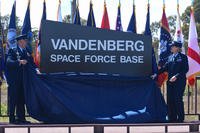While most coalition units in Afghanistan focus on drawing down, Air Force Brig. Gen. John Michel has a command that's growing.
In his second month as head of the NATO Air Training Command-Afghanistan (NATC-A), Michel currently has 649 personnel working for him -- 321 U.S. troops, 145 coalition troops from 17 countries, and 176 contractors --but "we're at an interesting inflection point," he said.
Michel said the total was projected to grow by 70 percent, or about 500 personnel, through 2017 in the job of training and equipping the Afghan Air Force (AAF).
In a phone interview from Bagram Air Base in Afghanistan, Michel took issue with the term "fledgling" that has become attached to the AAF. He said the term suggested that the AAF was "troubled and encumbered."
"We want to help people understand that the AAF isn't fledgling, it's flourishing," he said.
Michel will take that argument next week to the Air and Space Conference sponsored by the Air Force Association at the National Harbor exhibition center in suburban Maryland outside Washington, where he is scheduled to make a presentation on the Afghan Air Force's Future on Sept. 17.
U.S. sector commanders in Afghanistan have stressed the crucial role ahead for the AAF in being able to provide close air support and medical evacuations for the Afghan National Security Forces as all U.S. and coalition combat troops withdraw next year.
In a video briefing to Pentagon reporters from Afghanistan last month, Army Maj. Gen. Joseph McConville, head of Regional Command-East and the 101st Airborne Division, said that the major shortcoming for the Afghan ground forces was in their lack of close air support, although the Afghan Air Force was progressing in transporting troops and evacuating casualties with their Russian-made Mi-17 and Mi-35 helicopters.
To compensate for the lack of close air support, the Afghans have been relying on their Russian-made D-30 122 mm howitzers and 82mm and 60mm mortars for indirect fire in situations where U.S. troops would be most likely to call on fixed-wing aircraft or attack helicopters to hit enemy positions, McConville said.
"[The AAF is] starting to go to the most difficult places and resupply their troops," McConville said. "They're starting to go and casualty evac their troops, and so that's coming along."
"As they move forward, they're going to want some more close-air support whether that's provided by helicopters or that's provided by light attack aircraft," he said.
It will take years before the Afghan airmen reach full operational capability, McConville said, but once that's accomplished the AAF would have "the capability to be so strong that the enemies of the Afghanistan are not going to be willing to continue the conflict."
Michel, a command pilot with more than 3,300 hours in the C-17 and other aircraft, noted another vital mission for the AAF in Afghanistan --the swift removal of those killed on the battlefield for burial.
"To the Afghan people, this is their most important mission," Michel said referring to the Muslim religious tradition of honoring the dead with a swift burial.
In the last eight months, the AAF has performed more than 500 human remains missions, along with more than 1,000 casualty evacuations, Michel said. In recent actions, the AAF has been able to meet the NATO standard for performing medical evacuations within three hours, Michel said.
Michel noted the difficulties ahead for NATC-A in developing the AAF, which he said now has about 7,000 personnel active or in training, and is projected to have about 8,000 when fully operational.
"We're literally building an air force, not just from the ground up but from the inside out," Michel said.
In the last eight months, the AAF has carried out 2,200 missions, flown 32,000 passengers and delivered one million pounds of cargo, Michel said.
Michel also pointed to the political and legal problems involved in supplying the AAF with Russian-made Mi-17 helicopters and the fixed-wing A-29 Super Tucano turboprop, made by the Brazilian firm Embraer and its U.S. partner, the Sierra Nevada Corp., for close air support. Michel said he backed the purchase of both aircraft while stressing his command is not involved in acquisition decisions for the NATC-A.
Beechcraft Corp., maker of the similar A-6 turboprop, challenged the contract award to Embraer in the courts and lobbied against it in Congress, but Beechcraft's challenge was rejected.
The current $427 million contract for the A-29 calls for the delivery of 20 Super Tucanos to the AAF. Michel said he expected the first A-29 to come off the production line in Jacksonville, Fla., in June 2014.
The purchase for the AAF of Mi-17s from the state-run Russian arms exporter Rosoboronexport has come under withering criticism in Congress, where lawmakers from both parties have argued that the contract should go to U.S. firms. Sen. John Cornyn, R-Tex., and others have also questioned the morality of doing business with Rosoboronexport, which also is supplying arms to Syria.
Michel said the advantage that the Mi-17 has is the familiarity the Afghans have in flying them, going back to the Soviet occupation in the 1980s.
The Mi-17s are more maintenance-intensive, Michel said, but "it's very durable, it has great legs, and quite frankly, it's a tractor" in the form of a helicopter that has the power and maneuverability to operate effectively in the harsh terrain and high altitudes of Afghanistan.
Michel said the AAF currently has 46 of the Mi-17s, and nine more were expected to be delivered in October. Next month will also mark the arrival the first of two C130 aircraft to go into service with the AAF, Michel said. He said he had already planned a first mission for a C130 flown by the AAF on Oct. 10.
























